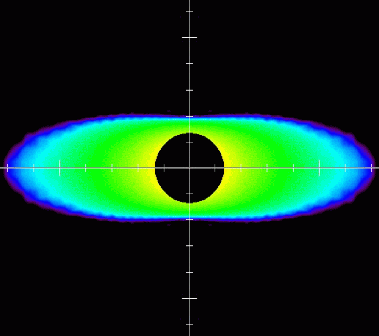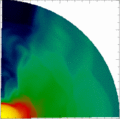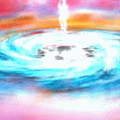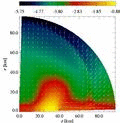 |


Go to:
-Introduction
-Current Members
-Previous Members
-Projects
-Quality of CFC
-Core Collapse with
Microphysics (Extended Model Set)
-Magnetorotational Stellar Core Collapse
-Core Collapse with
Microphysics
-Black Hole Formation
-Neutron Star Merger
-Rotating Neutron Stars
-Effective
Relativistic
Potential
-Mariage des Maillages
-Core Collapse in CFC+
-Blazar Light Curves
-Axisymmetric Core Collapse
Waveform Catalog
 Gravitational waves
Gravitational waves
from stellar core
collapse
Literature Catalog
 Gravitational waves
Gravitational waves
from stellar core
collapse
|
 |
 Introduction:
Introduction:
Many astrophysical phenomena can be simulated on computers using
methods known as computational hydrodynamics. If typical velocities
in the system are small and gravity is weak, it is sufficient to use
the Newtonian approximation of the laws of motion and gravity.
However, in many astrophysical environments, these approximations
do not hold. Supermassive black holes in quasars and solar-mass-sized
black holes with accretion discs power jets made of particles
which move at velocities close to the light speed. Here, special
relativistic hydrodynamics is needed for numerical simulations.
Our group has developed and successfully applied computer codes for
such simulations of jets with various sizes and morphologies for many
years.

To describe large amounts of matter compressed on small scales,
one must resort to general relativity, a generalization of
Newton's theory of gravity. Such a situation is encountered near black
holes (the prospective driving engines of astrophysical jets), as well
as in core collapse supernovae, in collapsars (one possible source of
gamma-ray bursts), or in neutron stars.
Some of these scenarios are emitting gravitational radiation. While
light or sound waves propagate through spacetime,
gravitational waves are ripples of spacetime itself. Such
spacetime distortions have been predicted by Einstein in his general
theory of relativity over 80 years ago, and are planned to be measured
by laser interferometers or resonant bar detectors. Such experiments
(like  GEO 600, GEO 600,
 LIGO, LIGO,
 VIRGO, VIRGO,
 LISA, or LISA, or
 IGEC)
have recently started very sensitive
measurements, and the first successful direct detection of
gravitational waves can be envisaged within the next 5 years. IGEC)
have recently started very sensitive
measurements, and the first successful direct detection of
gravitational waves can be envisaged within the next 5 years.

In order to accomplish a successful detection of gravitational waves,
very efficient electronic filters have to be employed to extract a
possible signal from the data measured by a detector. It is
therefore of great importance to predict as precise as possible the
signals from theoretical models of various astrophysical sources of
gravitational radiation. As part of the German research network
 SFB Transregio 7 "Gravitational Wave Astronomy",
our group takes part in this international interdisciplinary
scientific effort. SFB Transregio 7 "Gravitational Wave Astronomy",
our group takes part in this international interdisciplinary
scientific effort.
Additionally, in the development of numerical codes for simulations of both
special and general relativistic
hydrodynamics, our group is closely collaborating with scientists from
the  Departamento de Astronomía y Astrofísica at the Departamento de Astronomía y Astrofísica at the
 Universidad de Valencia in Spain, from the Universidad de Valencia in Spain, from the  Laboratoire de l'Univers et de ses Théories at the Laboratoire de l'Univers et de ses Théories at the  Observatoire de Paris in
France, and from the Observatoire de Paris in
France, and from the
 Numerical Relativity Group
at the Numerical Relativity Group
at the
 Max Planck Institute for Gravitational Physics in Potsdam, Germany. Max Planck Institute for Gravitational Physics in Potsdam, Germany.
 Current Members:
Current Members:
 Previous Members:
Previous Members:

|
Miguel A. Aloy
|
|
( Departamento de Astronomía y Astrofísica, Departamento de Astronomía y Astrofísica,
 Universidad de Valencia, Spain) Universidad de Valencia, Spain)
|

|
Harald Dimmelmeier
|
|
( Section of Astrophysics, Astronomy & Mechanics, Section of Astrophysics, Astronomy & Mechanics,
 Aristotle University of Thessaloniki, Greece) Aristotle University of Thessaloniki, Greece)
|

|
José A. Font
|
|
( Departamento de Astronomía y Astrofísica, Departamento de Astronomía y Astrofísica,
 Universidad de Valencia, Spain) Universidad de Valencia, Spain)
|
|
Volker Heesen
|
|
( Astronomisches Institut, Astronomisches Institut,
 Ruhr-Universität Bochum, Germany) Ruhr-Universität Bochum, Germany)
|
|
Tobias Leismann
|
|

|
Petar Mimica
|
|
( Departamento de Astronomía y Astrofísica, Departamento de Astronomía y Astrofísica,
 Universidad de Valencia, Spain) Universidad de Valencia, Spain)
|
|
Leonhard Scheck
|
|
Florian Siebel
|
|
( Institut für Geographie, Institut für Geographie,
 Ludwig-Maximilians-Universität München, Germany) Ludwig-Maximilians-Universität München, Germany)
|
|
Burkhard Zink
|
|
( Institute for Theoretical Physics, Institute for Theoretical Physics,
 Louisiana State University, U.S.A.) Louisiana State University, U.S.A.)
|
 Projects:
Projects:
Note that the order of the projects is roughly in the order of the
time of completion (oldest projects at the bottom).
-

 A Solution for the Nonuniqueness Problem of the Spacetime Constraint Equations A Solution for the Nonuniqueness Problem of the Spacetime Constraint Equations
I. Cordero-Carrión,
P. Cerdá-Durán,
H. Dimmelmeier,
J.L. Jaramillo,
J. Novak,
E. Gourgoulhon
The otherwise very successful CFC scheme for approximating the
Einstein equations in simulations of compact astrophysical objects
fail at very high densities. We have found a reformulation which
solves this problem and extends the applicability of CFC to e.g. black
hole formation.
-
 Gravitational Waves from Black Hole Formation
Gravitational Waves from Black Hole Formation
B. Zink, N. Stergioulas, I. Hawke, C.D. Ott,
E. Schnetter, E. Müller
Modeling the formation of ultracompact objects like neutron stars,
quark stars, or black holes, and the gravitational radiation emitted
by these catastrophic events is an intrinsically general relativistic
problem. Simulating the birth of black holes requires
advanced methods to solve the Einstein equations, relativistic
hydrodynamics, and horizon analysis.
-

 Nonlinear Axisymmetric Pulsations of Rotating Relativistic Stars Nonlinear Axisymmetric Pulsations of Rotating Relativistic Stars
H. Dimmelmeier, N. Stergioulas, J.A. Font
With the axisymmetric version of the  "Mariage des Maillage" code
we have for the first time simulated pulsations in uniformly and differentially rotating
neutron star models in general relativistic gravity and identified important
nonlinear effects. We have also investigated the issue of
detectability of gravitational wave emitted by such oscillations. "Mariage des Maillage" code
we have for the first time simulated pulsations in uniformly and differentially rotating
neutron star models in general relativistic gravity and identified important
nonlinear effects. We have also investigated the issue of
detectability of gravitational wave emitted by such oscillations.
-

 Synthetic Light Curves of BL Lac Objects Synthetic Light Curves of BL Lac Objects
P. Mimica, M.A. Aloy, E. Müller, W. Brinkmann
For the first time we have performed a two-dimensional simulation of
the internal shocks in a blazar jet under realistic conditions and
have computed the light curve resulting from the collision of two
dense shells moving with different velocities within a jet.
-

 Gravitational Radiation from Relativistic Rotational Core Collapse Gravitational Radiation from Relativistic Rotational Core Collapse
H. Dimmelmeier, J.A. Font, E. Müller
We have succeeded for the first time to simulate the
collapse of a rotating stellar core to a neutron star including
the effects of general relativity, making a major step forward
towards realistic predictions of gravitational wave signals.
 Comments to: Harald Dimmelmeier Comments to: Harald Dimmelmeier
 harrydee _at_ mpa-garching.mpg.de harrydee _at_ mpa-garching.mpg.de
|  |



 Introduction:
Introduction:

